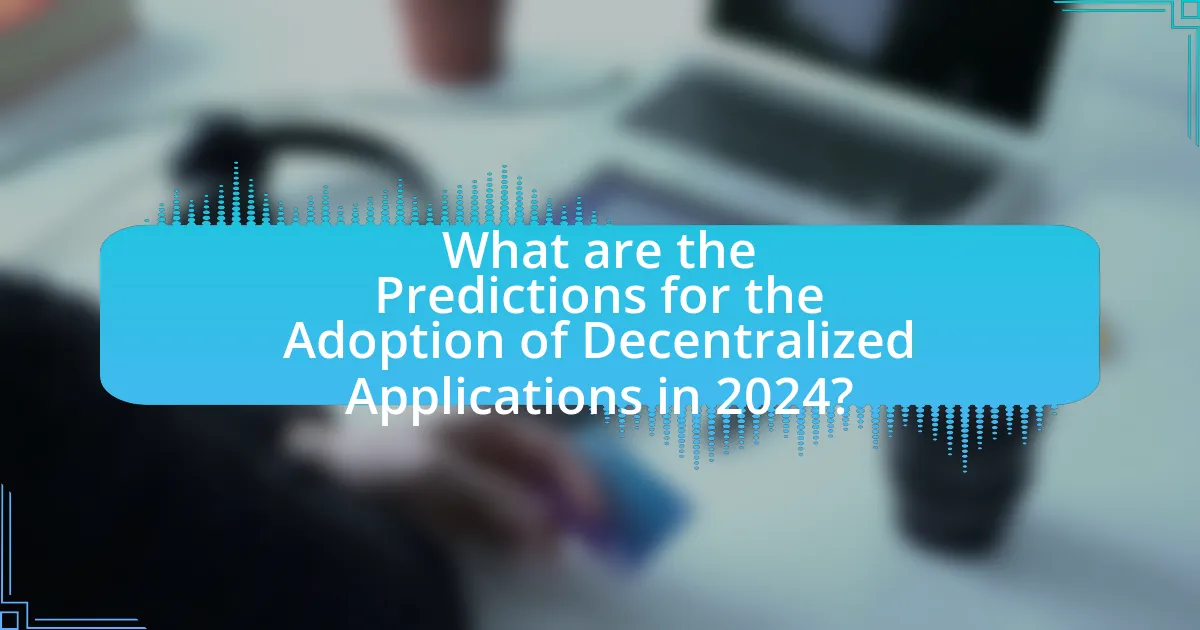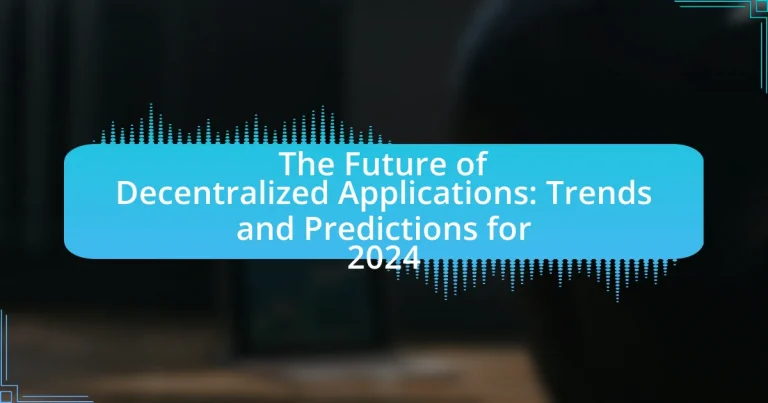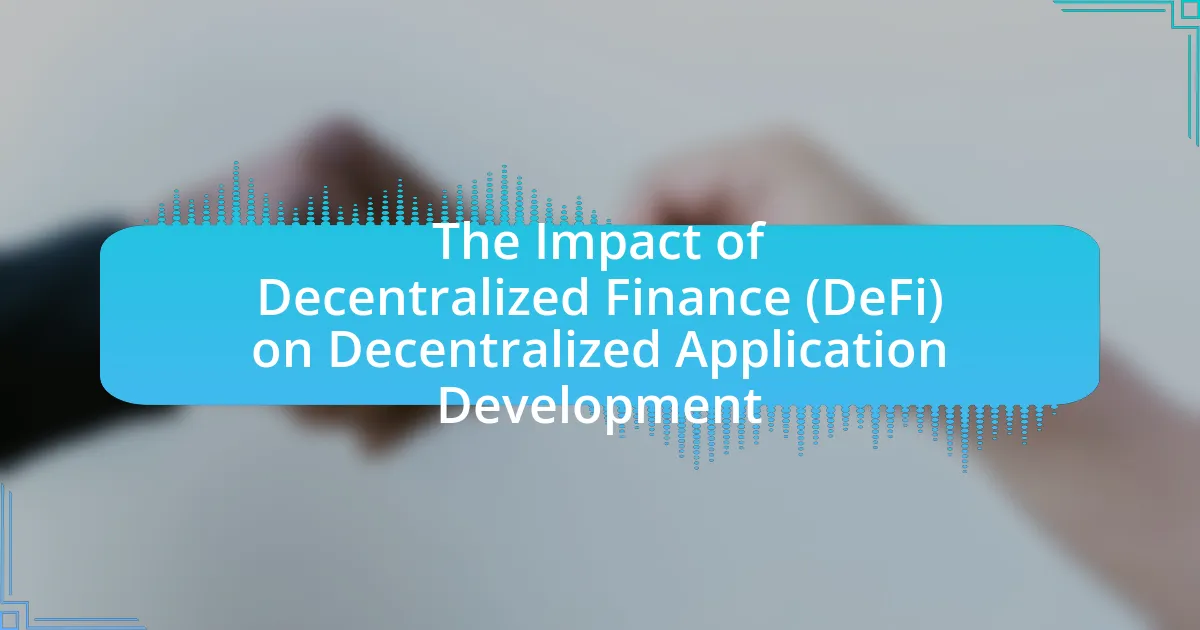Decentralized applications (dApps) are software applications that operate on blockchain or peer-to-peer networks, offering enhanced transparency, security, and user control over data. This article explores the significance of dApps for the future, highlighting their differences from traditional applications, key characteristics, and the critical role of decentralization. It examines current trends shaping the dApp landscape, including interoperability, user experience improvements, and the influence of blockchain technology. Additionally, the article addresses challenges such as scalability and security, while providing predictions for dApp adoption across various industries by 2024, particularly in finance and supply chain management.

What are Decentralized Applications and Why are They Important for the Future?
Decentralized applications (dApps) are software applications that run on a blockchain or peer-to-peer network, rather than being hosted on centralized servers. dApps are important for the future because they promote transparency, security, and user control over data, reducing reliance on centralized authorities. For instance, according to a report by Gartner, by 2025, 70% of enterprises will be using decentralized applications to enhance their operational efficiency and security. This shift indicates a growing trend towards decentralized solutions that empower users and foster innovation across various sectors.
How do Decentralized Applications differ from Traditional Applications?
Decentralized applications (dApps) differ from traditional applications primarily in their architecture and control mechanisms. dApps operate on a decentralized network, typically utilizing blockchain technology, which allows for greater transparency, security, and resistance to censorship. In contrast, traditional applications are usually hosted on centralized servers, giving a single entity control over the data and functionality. This fundamental difference means that dApps can provide users with more autonomy and privacy, as they do not rely on a central authority to manage transactions or data storage. For example, Ethereum-based dApps leverage smart contracts to automate processes without intermediaries, enhancing trust and efficiency.
What are the key characteristics of Decentralized Applications?
Decentralized applications (dApps) are characterized by their reliance on blockchain technology, which ensures transparency, security, and immutability. These applications operate on a peer-to-peer network, eliminating the need for a central authority, which enhances user control and privacy. Additionally, dApps utilize smart contracts to automate processes and enforce agreements without intermediaries, thereby increasing efficiency. The open-source nature of many dApps allows for community collaboration and innovation, while their token-based economies incentivize user participation and governance. These characteristics collectively contribute to the resilience and adaptability of dApps in various sectors.
Why is decentralization a critical feature for modern applications?
Decentralization is a critical feature for modern applications because it enhances security, promotes user autonomy, and increases system resilience. By distributing data and control across multiple nodes, decentralized applications reduce the risk of single points of failure and make it more difficult for malicious actors to compromise the system. For instance, blockchain technology, which underpins many decentralized applications, has demonstrated its ability to secure transactions through cryptographic methods and consensus mechanisms, as evidenced by the robust security of Bitcoin and Ethereum networks. Furthermore, decentralization empowers users by giving them control over their data and interactions, fostering trust and transparency in digital ecosystems.
What trends are shaping the future of Decentralized Applications in 2024?
The future of Decentralized Applications (dApps) in 2024 is being shaped by several key trends, including increased interoperability, enhanced user experience, and the rise of decentralized finance (DeFi) solutions. Interoperability among different blockchain networks is crucial, as it allows dApps to communicate and share data seamlessly, fostering a more integrated ecosystem. Enhanced user experience focuses on simplifying interfaces and improving accessibility, which is essential for attracting non-technical users. The growth of DeFi solutions continues to drive innovation, with more dApps offering financial services like lending, borrowing, and trading without intermediaries. These trends are supported by the increasing adoption of blockchain technology across various sectors, as evidenced by a report from Deloitte indicating that 76% of executives believe blockchain will be a critical part of their business strategy in the coming years.
How is blockchain technology influencing these trends?
Blockchain technology is significantly influencing trends in decentralized applications by enhancing security, transparency, and interoperability. The decentralized nature of blockchain allows applications to operate without a central authority, which reduces the risk of data breaches and fraud. For instance, according to a report by Deloitte, 40% of organizations are exploring blockchain for its ability to provide secure and transparent transactions. Additionally, blockchain facilitates interoperability among different platforms, enabling seamless integration and communication between various decentralized applications. This trend is further supported by the rise of cross-chain technologies, which allow assets and data to move freely across different blockchain networks, thereby fostering innovation and collaboration in the decentralized ecosystem.
What role do smart contracts play in the evolution of Decentralized Applications?
Smart contracts are essential to the evolution of decentralized applications (dApps) as they automate and enforce agreements without intermediaries. By executing predefined conditions on blockchain networks, smart contracts enhance trust, security, and efficiency in dApps. For instance, Ethereum’s smart contract functionality has enabled the creation of various dApps across finance, gaming, and supply chain sectors, demonstrating their transformative impact. The ability to facilitate complex transactions autonomously has led to increased adoption and innovation within the decentralized ecosystem, solidifying smart contracts as a foundational element in the development of future dApps.
What challenges do Decentralized Applications face moving forward?
Decentralized Applications (dApps) face several challenges moving forward, including scalability, user adoption, regulatory compliance, and security vulnerabilities. Scalability remains a significant issue, as many blockchain networks struggle to handle a high volume of transactions efficiently; for instance, Ethereum’s network congestion has led to high gas fees, which can deter users. User adoption is hindered by the complexity of dApps, as many potential users find them less intuitive than traditional applications. Regulatory compliance poses a challenge as governments worldwide are still developing frameworks to govern blockchain technology, creating uncertainty for developers and users alike. Lastly, security vulnerabilities, such as smart contract bugs and potential exploits, continue to threaten the integrity of dApps, evidenced by high-profile hacks that have resulted in significant financial losses.
How do scalability issues impact the adoption of Decentralized Applications?
Scalability issues significantly hinder the adoption of Decentralized Applications (dApps) by limiting their ability to handle a growing number of users and transactions efficiently. When dApps cannot scale effectively, they experience slower transaction speeds and higher fees, which deter users seeking seamless and cost-effective experiences. For instance, Ethereum, a leading platform for dApps, has faced congestion during peak usage times, resulting in transaction delays and costs that can exceed $50, as observed during the DeFi boom in 2020. This inefficiency leads to user frustration and a preference for centralized alternatives that offer faster and cheaper services. Consequently, the inability to scale undermines the fundamental advantages of decentralization, such as accessibility and user empowerment, ultimately stalling broader adoption.
What security concerns must be addressed for Decentralized Applications?
Decentralized applications (dApps) must address several security concerns, including smart contract vulnerabilities, data privacy, and user authentication. Smart contract vulnerabilities can lead to exploits, as evidenced by the DAO hack in 2016, where $60 million was stolen due to a flaw in the smart contract code. Data privacy is critical, as decentralized systems often expose user data on public ledgers, necessitating robust encryption methods. Additionally, user authentication is essential to prevent unauthorized access, with solutions like decentralized identity systems being explored to enhance security. Addressing these concerns is vital for the safe adoption and functionality of dApps in the future.

How will User Experience evolve in Decentralized Applications by 2024?
User Experience in Decentralized Applications will evolve significantly by 2024 through enhanced usability, streamlined onboarding processes, and improved interoperability. As decentralized applications become more mainstream, developers will prioritize user-friendly interfaces that simplify complex blockchain interactions, making them accessible to non-technical users. For instance, initiatives like WalletConnect and Universal Wallets are already paving the way for seamless integration across various platforms, allowing users to manage multiple assets effortlessly. Additionally, advancements in layer-2 solutions will reduce transaction costs and latency, further enhancing the overall user experience. According to a report by ConsenSys, 75% of users cite ease of use as a critical factor in adopting decentralized technologies, underscoring the importance of user-centric design in the evolution of these applications.
What improvements in usability can we expect?
Improvements in usability for decentralized applications (dApps) in 2024 are expected to include enhanced user interfaces, streamlined onboarding processes, and increased interoperability. Enhanced user interfaces will simplify navigation and interaction, making dApps more accessible to non-technical users. Streamlined onboarding processes will reduce the complexity of wallet setup and transaction initiation, as evidenced by the rise of user-friendly wallets that require minimal technical knowledge. Increased interoperability among different blockchain networks will allow users to interact seamlessly across platforms, improving the overall user experience. These advancements are supported by ongoing developments in blockchain technology and user experience design, which prioritize usability to drive wider adoption.
How will user interfaces change to accommodate new users?
User interfaces will change to accommodate new users by becoming more intuitive and user-friendly, focusing on simplicity and accessibility. As decentralized applications evolve, they will prioritize onboarding experiences that reduce complexity, utilizing guided tutorials and contextual help features. Research indicates that 70% of users abandon applications due to poor usability, highlighting the need for interfaces that cater to varying levels of technical expertise. Enhanced personalization through adaptive interfaces will also play a crucial role, allowing users to customize their experience based on preferences and usage patterns.
What role does community feedback play in enhancing user experience?
Community feedback plays a crucial role in enhancing user experience by providing developers with direct insights into user needs and preferences. This feedback allows for iterative improvements, ensuring that applications align with user expectations and resolve pain points effectively. For instance, a study by Nielsen Norman Group found that user feedback can lead to a 50% increase in user satisfaction when incorporated into design processes. By actively engaging with the community, developers can prioritize features that matter most to users, ultimately fostering a more user-centric approach in decentralized applications.
How will interoperability between Decentralized Applications develop?
Interoperability between Decentralized Applications (dApps) will develop through the implementation of cross-chain protocols and standards that facilitate seamless communication and data exchange. As blockchain technology evolves, projects like Polkadot and Cosmos are leading the way by enabling different blockchains to interoperate, allowing dApps to access resources and functionalities across multiple networks. This development is supported by the increasing demand for user-friendly experiences and the need for diverse functionalities, which drive developers to create solutions that bridge gaps between isolated ecosystems.
What are the benefits of cross-chain compatibility?
Cross-chain compatibility allows different blockchain networks to communicate and interact with each other, enhancing interoperability. This capability enables users to transfer assets and data seamlessly across various platforms, which increases liquidity and market efficiency. For instance, cross-chain solutions can facilitate decentralized finance (DeFi) applications by allowing users to leverage assets from multiple blockchains, thereby broadening investment opportunities and reducing reliance on a single network. Additionally, cross-chain compatibility fosters innovation by enabling developers to build applications that utilize the strengths of multiple blockchains, leading to more robust and versatile decentralized applications.
How can developers ensure seamless integration across platforms?
Developers can ensure seamless integration across platforms by utilizing standardized APIs and protocols. Standardized APIs facilitate consistent communication between different systems, allowing for easier data exchange and functionality across various platforms. For instance, RESTful APIs are widely adopted due to their simplicity and compatibility with multiple programming languages, which enhances interoperability. Additionally, employing cross-platform development frameworks, such as React Native or Flutter, enables developers to write code once and deploy it across multiple platforms, further streamlining the integration process. This approach is supported by the fact that according to a survey by Stack Overflow, 70% of developers prefer using frameworks that allow for cross-platform compatibility, indicating a strong industry trend towards seamless integration solutions.

What are the Predictions for the Adoption of Decentralized Applications in 2024?
Predictions for the adoption of decentralized applications (dApps) in 2024 indicate significant growth, with estimates suggesting a 30% increase in user engagement compared to 2023. This growth is driven by advancements in blockchain technology, increased regulatory clarity, and a rising demand for privacy and security in digital transactions. According to a report by Gartner, the number of active dApps is expected to surpass 10,000 by the end of 2024, reflecting a broader acceptance across various industries, including finance, gaming, and supply chain management.
Which industries are likely to adopt Decentralized Applications first?
The finance and banking industries are likely to adopt Decentralized Applications (dApps) first. This is evidenced by the increasing interest in blockchain technology for secure transactions, smart contracts, and decentralized finance (DeFi) solutions. According to a report by Deloitte, 40% of financial services firms are already exploring blockchain technology, indicating a strong inclination towards integrating dApps into their operations. Additionally, sectors such as supply chain management and healthcare are also expected to follow closely, as they seek to enhance transparency and data security through decentralized solutions.
How will finance and banking sectors leverage Decentralized Applications?
Finance and banking sectors will leverage Decentralized Applications (dApps) to enhance transaction efficiency, reduce costs, and improve security. By utilizing blockchain technology, these sectors can facilitate peer-to-peer transactions without intermediaries, which can lower fees and speed up processing times. For instance, dApps can enable smart contracts that automate and enforce agreements, minimizing the need for manual oversight and reducing the potential for fraud. According to a report by Deloitte, the adoption of blockchain in financial services could save banks up to $20 billion annually by streamlining operations and reducing transaction costs.
What potential do Decentralized Applications have in supply chain management?
Decentralized Applications (dApps) have significant potential in supply chain management by enhancing transparency, efficiency, and security. These applications utilize blockchain technology to create immutable records of transactions, allowing all stakeholders to access real-time data regarding the movement of goods. For instance, a study by Accenture found that blockchain could reduce supply chain-related costs by up to 30% by streamlining processes and minimizing fraud. Furthermore, dApps facilitate smart contracts, which automate and enforce agreements between parties, reducing delays and disputes. This capability not only accelerates transactions but also ensures compliance with regulatory standards, thereby improving overall supply chain integrity.
What are the expected impacts of regulatory changes on Decentralized Applications?
Regulatory changes are expected to significantly impact Decentralized Applications (dApps) by introducing compliance requirements that may alter their operational frameworks. These changes could lead to increased scrutiny from regulatory bodies, necessitating dApps to implement Know Your Customer (KYC) and Anti-Money Laundering (AML) protocols, which could hinder user anonymity and decentralization principles. For instance, the European Union’s Markets in Crypto-Assets (MiCA) regulation aims to create a comprehensive regulatory framework for crypto assets, which directly affects how dApps operate within the EU. This regulatory landscape may also drive innovation as developers seek to create compliant solutions while maintaining the core benefits of decentralization.
How might governments influence the development of Decentralized Applications?
Governments can influence the development of Decentralized Applications (dApps) through regulatory frameworks, funding initiatives, and partnerships with private sector entities. Regulatory frameworks can establish guidelines that either promote or hinder innovation in dApp development; for instance, countries like Switzerland have created favorable regulations that encourage blockchain technology, while others impose strict regulations that may stifle growth. Additionally, governments can provide funding and grants to support research and development in decentralized technologies, as seen in initiatives by the European Union to foster blockchain innovation. Furthermore, partnerships between governments and tech companies can lead to the creation of public dApps that serve civic purposes, enhancing the utility and adoption of decentralized technologies.
What compliance challenges could arise for developers and users?
Compliance challenges for developers and users of decentralized applications (dApps) include navigating regulatory frameworks, ensuring data privacy, and adhering to anti-money laundering (AML) and know your customer (KYC) requirements. Developers must contend with varying regulations across jurisdictions, which can lead to legal uncertainties and potential penalties for non-compliance. Users face risks related to their personal data being exposed or misused, as decentralized systems often lack centralized oversight. Furthermore, the decentralized nature of these applications complicates the enforcement of compliance measures, making it difficult to implement KYC and AML protocols effectively. These challenges are underscored by the increasing scrutiny from regulatory bodies, as seen in the European Union’s proposed regulations on digital assets, which aim to create a comprehensive legal framework for cryptocurrencies and dApps.
What practical steps can developers take to prepare for the future of Decentralized Applications?
Developers can prepare for the future of Decentralized Applications (dApps) by enhancing their knowledge of blockchain technology and smart contracts. This foundational understanding is crucial, as it enables developers to create more efficient and secure dApps. Additionally, developers should engage with existing decentralized ecosystems, such as Ethereum and Polkadot, to gain practical experience and insights into current best practices.
Moreover, staying updated on regulatory changes and compliance requirements is essential, as these factors significantly impact the development and deployment of dApps. Participating in developer communities and attending relevant conferences can also provide valuable networking opportunities and insights into emerging trends.
Finally, focusing on user experience and scalability will be vital, as these aspects will determine the adoption and success of dApps in the future. By taking these steps, developers can position themselves effectively in the evolving landscape of decentralized applications.
How can developers stay updated with emerging trends and technologies?
Developers can stay updated with emerging trends and technologies by actively engaging in continuous learning through various channels. These channels include following industry-leading blogs, participating in online courses, attending webinars, and joining professional communities on platforms like GitHub and Stack Overflow. For instance, a report by the World Economic Forum highlights that 94% of employees believe that continuous learning is essential for career success, emphasizing the importance of staying informed in a rapidly evolving tech landscape. Additionally, subscribing to newsletters from reputable tech organizations and attending conferences can provide insights into the latest advancements and best practices in decentralized applications and other technologies.
What best practices should be followed for building resilient Decentralized Applications?
To build resilient Decentralized Applications (dApps), developers should prioritize security, scalability, and user experience. Security is paramount; implementing robust cryptographic techniques and conducting regular audits can mitigate vulnerabilities. Scalability is essential for handling increased user demand; utilizing layer-2 solutions or sharding can enhance performance. User experience should not be overlooked; intuitive interfaces and seamless onboarding processes can significantly improve user retention. These best practices are supported by industry standards, such as the Ethereum community’s emphasis on security audits and the adoption of layer-2 scaling solutions like Optimistic Rollups, which have shown to effectively increase transaction throughput while maintaining decentralization.

















